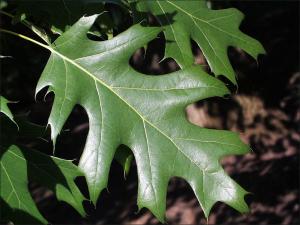Purest of Noble Trees
By Lynne Pieri-Finn, Fairfax Master Gardener Intern
The real voyage of discovery consists of not in seeking new landscapes but in having new eyes. — Marcel Proust

White Oak
With each tree I learned, I had a new favorite. I loved the oaks, so we’ll talk about that in this article. There are whole books on oaks alone. If you cannot identify an oak right away, look at the leaves. Most are lobed, sometimes deeply. The deep indentations in the lobes are called sinuses and may be deeply cut to the midrib or not. Good examples of lobes deeply cut or not are the Southern Red Oak (Q. falcata) and the Chestnut Oak (Q. montana). Of course, the Willow Oak (Q. phellos) is an important exception; its leaves are long and entire, like a willow leaf.

Pin Oak
By the way, 2019 was what they call a mast year for oaks and other nut-producing trees. Mast years are high-production years. Acorns were everywhere, and the squirrels had a nice feast. Early humans also ate acorns; in fact, it was one of the main staples of their diet. They leeched out the tannins and made the paste into flour or a jelly-like cake. In Korean stores, you can still find it. It is called Dotori-muk. Oaks ranged from Asia, through Europe and the Americas.
Oaks are in the Fagaceae family. All oaks have the genus Quercus. There are two main groups of oaks: white oaks and red oaks. Let’s start with differences:
| White Oaks | Red Oaks |
| Rounded tips of leaves | Bristle-tipped leaves |
| Rounded buds, reddish brown | Pointed buds |
| Acorn cap surface mostly smooth | Acorn cap surface wooly |
| Acorns mature in one growing season | Acorns mature in two growing seasons |
| Squirrels like acorns (staple of early human diet) | Acorns taste bitter |
| Grayish, scaly, soft bark | Hard, dark-colored bark |
| Wood hard and strong | Wood somewhat hard |
Wind-pollinated flowers on trees do not necessarily have to be conspicuous. Flowers that need pollinators need to attract them, hence, big and conspicuous. The cones on conifers, also monoecious, are mostly near the top of the tree to catch the wind.
With all this wind-pollination going on, it is easy for different species of oaks to cross-pollinate. However, the vast majority of oak trees are still recognizable to species. This shows us that hybridization tends not to lead to new species formation very often. Part of the reason for this is that some hybrid oaks do not reproduce — they are as sterile as a mule. Interestingly, this only happens with the red oak group. Identification can stump the experts.

Red Oak Leaves
Rule of thumb: rounded lobes = white oak; bristle-tips = red oak. Look at the differences between the Post Oak (Q. stellata) and the Northern Red Oak (Q. rubra). Additional red oaks in our area are the Southern Red Oak (Q. falcata), the Blackjack Oak (Q. marilandica) and the Black Oak (Q. velutina), which is not “red” at all but has bristle tips. Some white oaks you’ll see in our area are the Swamp White Oak (Q. bicolor), the White Oak (Q. alba) and the Durand Oak (Q. sinuata).

Black Oak
In fact, there are cultivars of many types of trees which look nothing like the original.
Now that you are on your way to recognizing trees on your daily strolls, say hello, and like good neighbors, it is nice to know their names.
Resources
The Tree Book by Michael A. Dirr and Keith S. Warren
Seeing Trees by Nancy Ross Hugo, with photos by Robert Llewellyn
Remarkable Trees of Virginia, by Nancy Ross Hugo and Jeff Kirwan, photography by Robert Llewellyn